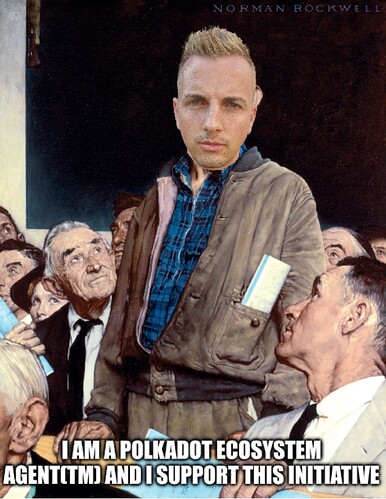A Polkadot Ecosystem Agents™ Initiative
We are proposing adjustments to OpenGov in retrospect of the community’s engagement over the last 24 months of proposals, voting and dialog.
This proposal seeks to decrease noise for voters and increase accountability of proponents.
The adjustments are conceptually part of a broader framework and vision for the future of OpenGov - we see the long term vision of the treasury transforming by moving the majority of spending to bounties, or collectives which allow for better domain knowledge, scope, and cost negotiation. The long term vision also includes agreed-upon budgeting per domain area, greater transparency across bounty spending, and enhanced controls for managing and promoting competent talent within the ecosystem inside the bounty system.
Next week we will post this on-chain as a Wish For Change (WFC) to seek alignment from the community on this new vision.
The short term adjustments revolve around increasing the quality of submissions and reducing the noise and effort that is required from governance participants. We see this as a large time and brain drain from the ecosystem with a huge opportunity cost for those actively involved.
The short term adjustments involve, per track:
-
Increasing the Submission Deposit from 1 DOT to 10 DOT
-
Increasing Decision Deposits
-
Increasing the minimum Support Turn-out
-
Decreasing the Max Deciding referendum
(number of active referendum allowed per track) -
Making the Referendum Canceller easier to submit.These adjustments have all been modeled against previous OpenGov proposals to ensure that high quality proposals will still pass with these new adjustments.
The Submission Deposit has been increased to help reduce spam proposals or “just vote nay” (submission errors). Any submission deposits on failed proposals result in this DOT being locked forever and unable to be claimed (effectively burnt). The aim of increasing this to 10 DOT should help prospective proponents to take more care when raising governance proposals.
Increasing the Decision Deposit should force proponents requesting funds to have a greater stake in the ecosystem and network or may require proponents to seek an aligned sponsor for large spends if they are coming from outside of the Polkadot ecosystem.
Increasing the minimum Support Turn-Out will help ensure that only well aligned proposals that really engage the community make it through and are funded / approved.
Decreasing the Max Deciding will increase efficiency of spending, help reduce noise for involved parties, and therefore decrease voting fatigue. This proposal decreases the maximum possible active governance proposals across four tracks from 160 down to 15. Similar to Gov 1, this can lead to a queue of waiting proposals and the proposal with the most support in the queue will become active (go into voting) next. This helps increase the quality of proposals and slows down OpenGov, allowing participants to focus on proposals and have a more robust discussion period before and during active voting.
Making Referendum Canceller cheaper to submit ensures that if there are active proposals which are very likely to fail - e.g. 90% NAY with a strong support, then these proposals can be cancelled to clear up the active spots, allowing another proposal to be voted on, without having to wait the full voting duration.
The following tracks are included in the proposed short term adjustments:
-
Treasurer
-
Small spender
-
Medium spender
-
Big spender
-
Referendum canceller
These tracks account for 60% of all treasury proposals raised since OpenGov’s launch. These adjustments have been tracked in the following document and are as follows:
-
Treasurer
-
Max deciding, decreased from 10 to 2
-
Decision Deposit, increased from 1,000 to 25,000 DOT
-
Min Support Turn Out increased from 0% to 1.5%
-
-
Small spender
-
Max deciding decreased from 50 to 5
-
Decision deposit increased from 100 to 500 DOT
-
Min Support Turn Out increased from 0% to 0.5%
-
-
Medium spender
-
Max deciding decreased from 50 to 5
-
Decision deposit increase from 200 to 1,000
-
Min Support Turn Out increased from 0% to 1%
-
-
Big Spender
-
Max deciding decreased from 50 to 3
-
Decision deposit increase from 400 to 5,000
-
Min Support Turn Out increased from 0% to 1%
-
Approval increased from 50% to 60%
-
-
Referendum Canceller
-
Max deciding decreased from 1,000 to 500
-
Decision deposit decreased from 10,000 to 5,000
-
These proposed adjustments to OpenGov represent an evolution in how we use the Polkadot treasury.
By reducing the amount of incoming treasury proposals we will have more time to evaluate the proposals raised, increasing the quality of our decision making.
By raising deposits, tightening active proposal limits, and optimising cancellation mechanics, we seek to elevate the quality of governance activity and increase alignment within the network participants, while minimizing the time and energy drain on participants.
This WFC will mark a clear step toward a more focused, sustainable, and scalable OpenGov for all.

